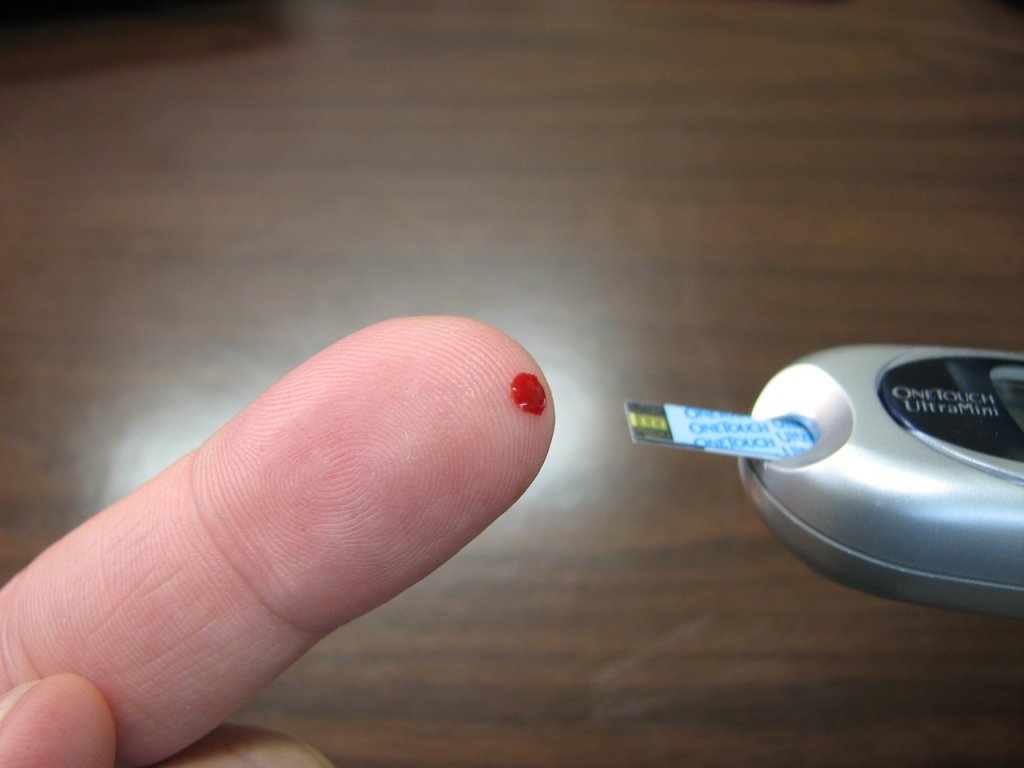
Diabetes and Gout
A 2014 study has shown that people with gout are at a higher risk of type 2 diabetes than people who don’t have gout.
So what’s the connection between diabetes and gout? How are they related? Are they related?
That’s what we’re going to look at today.
But first, let’s take a high-level look at each condition to help give us a better understanding of how they may be linked, if at all…
What is Gout?
Gout is a form of inflammatory arthritis caused by too-high blood uric acid levels (a condition called hyperuricemia) out of which monosodium urate crystals can form in the joints and surrounding tissue — the majority of times in the joint at the base of the big toe.
Uric acid is a byproduct of purine metabolism. Purines are natural chemical compounds that exist in our body’s cells and in the cells of the food we eat. As purines breakdown they produce uric acid.
Higher than normal uric acid concentrations in the blood usually occur as a result of poor uric acid excretion or overproduction, i.e. the kidneys not expelling enough through urine or the body producing more uric acid than the kidneys can handle.
The body’s “foreign body” reaction to those monosodium urate crystals is an inflammatory response that floods the area with white blood cells and inflammatory mediators which produce the typical gout symptoms of swelling, inflammation, stiffness, shiny redness and, of course, excruciating pain.
What is Type 2 Diabetes?
Note: I use “sugar” and “glucose” interchangeably here.
Type 2 diabetes is the most common form of diabetes (around 90% – 95% of cases), a chronic condition that results from a body’s inability to produce enough or use enough insulin, a hormone that controls blood sugar (glucose) levels so that the levels never get too high (hyperglycemia) or too low (hypoglycemia), both of which are very serious, life-threatening conditions.
Your body’s cells need glucose as fuel to produce energy, which glucose comes from carbohydrates in the food you eat. As your food is digested, your blood sugar level rises and triggers the pancreas to release insulin proteins into the bloodstream which attach themselves to your body’s cells and directs them to adsorb the sugar. Cells cannot adsorb glucose directly from the blood. They need that insulin.
But if your body isn’t using the insulin properly (insulin resistance) it means that cells cannot adsorb the sugar which then remains in the blood. And as more food is digested, sugar levels rise even further, and more insulin is released into the bloodstream to deal with it. It’s a vicious cycle that can eventually end up overstressing the pancreas and impeding its ability to produce enough insulin.
Common type 2 diabetes symptoms are frequent urination, excessive thirst, tiredness, drowsiness, blurred vision, genital itching, thrush, and slow healing cuts and wounds.
It’s interesting to note that some 25% of people with type 2 diabetes are unaware they have it. So if you suffer from any of these symptoms see your doctor right away.
What’s the Link Between Type 2 Diabetes and Gout?
Although more than one study has shown that having gout puts you at a high risk of having diabetes, researchers aren’t sure why.
We know that high uric acid causes gout and at least one study has shown that high serum uric acid may induce insulin resistance, a trigger for diabetes.
It’s also known that gout causes inflammation in the body and some researchers believe inflammation may play a role in type 2 diabetes.
However, the experts just cannot say with any certainty that having one actually causes the other. So far, they haven’t been able to prove any causal relationship. All they can point to is what seems like a clear “association” between gout and diabetes.
But, both conditions have several high risk factors in common.
The risk for both conditions increases with:
- being overweight or obese
- drinking too much alcohol
- consuming too much sugar
- having high blood pressure (hypertension)
Let’s take a look at how each risk factor affects each condition:
1. Being Overweight or Obese
Gout
People who are obese are 4x more likely to get gout than a person with normal weight. And the more overweight they are the higher the risk. So being overweight is a major risk factor for gout.
- Being overweight provides more body tissue and so more purines that produce more uric acid.
- And, since the individual is probably eating way too much purine-rich food, this adds even more uric acid into the bloodstream.
- In addition, being overweight also impedes the kidneys’ ability to process and remove uric acid from the body, leading to raised uric acid levels in the blood.
Type 2 Diabetes
Around 90% of people with type 2 diabetes are overweight or obese. So being overweight is a key determinant of type 2 diabetes.
- It’s thought that being overweight / obese causes stresses inside the body’s cells by overloading them with too much nutrients through overeating.
- To combat this the cells try to reduce glucose adsorption by impeding the insulin receptors on their surface. In other words, inducing insulin resistance which leads to high blood glucose levels and diabetes.
2. Drinking Too Much Alcohol
Gout
Heavy drinking — especially of beer — is a major trigger for gout.
- Alcohol disrupts the kidneys’ ability to manage and excrete uric acid, leading to high blood uric acid.
- Alcohol causes dehydration, and urate crystals can form much more readily in a dehydrated body.
- The sugar in alcoholic drinks can raise uric acid levels in the bloodstream.
- The yeast in beer is a high-purine food. So more purine intake — more uric acid produced.
Type 2 Diabetes
Heavy drinking can increase the risk of type 2 diabetes in a number of ways:
- It can cause insulin resistance which, as you saw above, can lead to type 2 diabetes.
- It can cause chronic pancreatitis (inflammation of the pancreas), impeding the pancreas’s ability to produce insulin.
- Alcohol, especially beer and some wines, often contain a lot of sugar that can result in being overweight; a major risk factor for type 2 diabetes.
3. Consuming Too Much Sugar (Especially in Soft Drinks)
Gout
High fructose consumption has been linked to increased uric acid.
- HFCS (high fructose corn syrup) is the sweetener of choice in soft drinks and many processed foods.
- Too much fructose consumption can increase uric acid levels in the blood.
- It has been discovered that when the liver has to deal with too much fructose, it results in elevated uric acid.
- High fructose consumption increases body weight, one of the highest risk factors for raised uric acid levels and gout.
Type 2 Diabetes
According to a 2010 study, the risk of developing diabetes is 26 % higher for those who drink one or more sugary drinks every day.
- It’s believed that the regular consumption of sugar sweetened soft drinks increases glucose intolerance and insulin resistance.
- And regular sugary drinks consumption also leads to unwanted weight gain, a high risk factor for type 2 diabetes.
Note: Regular consumption of processed foods containing sugar and refined carbs increases the risk of both conditions in the same way as sugary drinks.
4. Having High Blood Pressure
Gout
According to a 2014 study hypertension is a major risk factor for gout.
- Approximately 75% of gout patients have high blood pressure.
- And diuretics, taken to combat high blood pressure, can raise uric acid levels in the blood.
- So both the condition and the medicine used to alleviate it increases the risk of gout.
Type 2 Diabetes
A 2015 study concluded that people with high blood pressure have a higher risk of developing type 2 diabetes.
- Around 80% of people with type 2 diabetes have high blood pressure.
- But researchers don’t know why there’s such a compelling relationship between the two conditions.
- There is a view that inflammation in the body arising from hypertension may play a role.
How to Reduce the Risk of Type 2 Diabetes If You Have Gout
If you’ve got gout, you can reduce your risk of diabetes, as well as managing your gout, by confronting the common risk factors of weight, alcohol, sugar, and hypertension.
And this is vital since having both conditions together significantly increases the risk of heart attack, stroke, and kidney disease.
Now, when you were first diagnosed with gout, your doctor almost certainly would have advised you to make some important lifestyle and dietary changes to help you manage your condition. These changes being focused on reducing and maintaining your uric acid at healthy levels.
So an important part of this regimen is to avoid foods that are known to promote high uric acid levels.
For example, these foods are high in purines (which produce uric acid) and should be avoided:
- fatty red meat (beef, lamb, mutton)
- game (e.g. wild boar, squirrel, rabbit)
- organ meats (e.g. liver, kidneys, heart, sweetbreads)
- some fish (e.g. anchovies, sardines, pilchards, herring, mackerel)
- shellfish (e.g. oysters, prawns, langoustines, shrimp, lobster)
- foods containing brewer’s or baker’s yeast
And remember, high uric acid has also been linked to insulin resistance, so that removing these from your diet will help to reduce the risk of type 2 diabetes as well.
But it’s known that sugar consumption can also result in elevated uric acid (gout) as well as blood sugar (diabetes) and so the following should be avoided too:
-
- all forms of sugar (even honey, agave nectar, and maple syrup)
- sweetened breakfast cereals
- high carb processed foods (carbs turn to sugar in the body)
- prepackaged snacks
- fruit juices (even natural fruit juices)
- flavored milks and yogurt
- soft / fizzy drinks (incl. energy drinks)
- dried fruit
You can see why these dietary changes can have a profound impact on managing your gout and reducing the risk of diabetes.
And, of course, lifestyle changes can have a massive beneficial impact too. For example, regular exercise and limiting or avoiding alcohol will help shed those excess pounds and lower blood pressure; high risk factors for both gout and diabetes.
[Detailed A to Z lists of foods to avoid, foods to eat in moderation, and foods that are safe, are included in Gout Rescue along with 60+ delicious meal ideas.]
The Bottom Line
Although the experts aren’t sure why someone with gout is at a higher risk of type 2 diabetes than someone without gout, by relentlessly focusing on the common risk factors it’s possible to manage your gout and, at the same time, reduce your risk of type 2 diabetes going forward.




